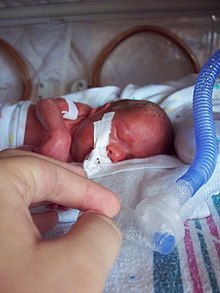
Back عدوى الأطفال حديثي الولادة Arabic Infección neonatal Spanish זיהום ולדי HE Նորածնային ինֆեկցիաներ Armenian Zakażenia okresu noworodkowego Polish Infecção perinatal Portuguese ළදරු ආසාදන Singhalese Nhiễm trùng sơ sinh Vietnamese 新生儿感染 Chinese
| Neonatal infection | |
|---|---|
 | |
| 26-week gestation, premature infant, weighing <990gm with ventilator | |
| Specialty | Infectious disease, Pediatrics |
Neonatal infections are infections of the neonate (newborn) acquired during prenatal development or within the first four weeks of life.[1] Neonatal infections may be contracted by mother to child transmission, in the birth canal during childbirth, or after birth.[2] Neonatal infections may present soon after delivery, or take several weeks to show symptoms. Some neonatal infections such as HIV, hepatitis B, and malaria do not become apparent until much later. Signs and symptoms of infection may include respiratory distress, temperature instability, irritability, poor feeding, failure to thrive, persistent crying and skin rashes.
Risk factors include previous maternal infection, preterm delivery (< 37 weeks gestation) and premature rupture of membranes (breakage of the amniotic sac) which substantially increases the risk of neonatal sepsis by allowing passage for bacteria to enter the womb prior to the birth of the infant. Preterm or low birth weight neonates are more vulnerable to neonatal infection. While preterm neonates are at a particularly high risk, all neonates can develop infection. Maternal screening for intrapartum infections reduce the risk of neonatal infection. Pregnant women may receive intrapartum antibiotic prophylaxis for prevention of neonatal infection.[3]
Infant respiratory distress syndrome is a common complication of neonatal infection, a condition that causes difficulty breathing in preterm neonates. Respiratory distress syndrome can arise following neonatal infection, and this syndrome may have long-term negative consequences. In some instances, neonatal respiratory tract diseases may increase the susceptibility to future respiratory infections and inflammatory responses related to lung disease.[4]
Antibiotics can be effective for neonatal infections, especially when the pathogen is quickly identified. Instead of relying solely on culturing techniques, pathogen identification has improved substantially with advancing technology; however, neonate mortality reduction has not kept pace. In industrialized countries, treatment for neonatal infections takes place in the neonatal intensive care unit (NICU). Neonatal infection can be distressing to the family and it initiates concentrated effort to treat it by clinicians. Research to improve treatment of infections and prophylactic treatment of the mother to avoid infections of the infant is ongoing.[5]
- ^ Neil K. Kaneshiro; David Zieve; Isla Ogilvie, eds. (December 4, 2013). "Neonate". U.S. National Library of Medicine. Retrieved January 16, 2016.
- ^ Mary T. Caserta (October 2015). "Overview of Neonatal Infections". Merck Sharp & Dohme Corporation. Retrieved January 16, 2015.
- ^ Singh M, Alsaleem M, Gray CP (September 2022). Neonatal Sepsis. StatPearls [Internet]. StatPearls Publishing. PMID 30285373. NBK531478.
- ^ Reuter S, Moser C, Baack M (October 2014). "Respiratory distress in the newborn". Pediatr Rev. 35 (10): 417–28, quiz 429. doi:10.1542/pir.35-10-417. PMC 4533247. PMID 25274969.
- ^ Brenda L Tesini (September 2022). "Antibiotics in Neonates". Merck Sharp & Dohme Corporation. Retrieved February 16, 2023.
© MMXXIII Rich X Search. We shall prevail. All rights reserved. Rich X Search